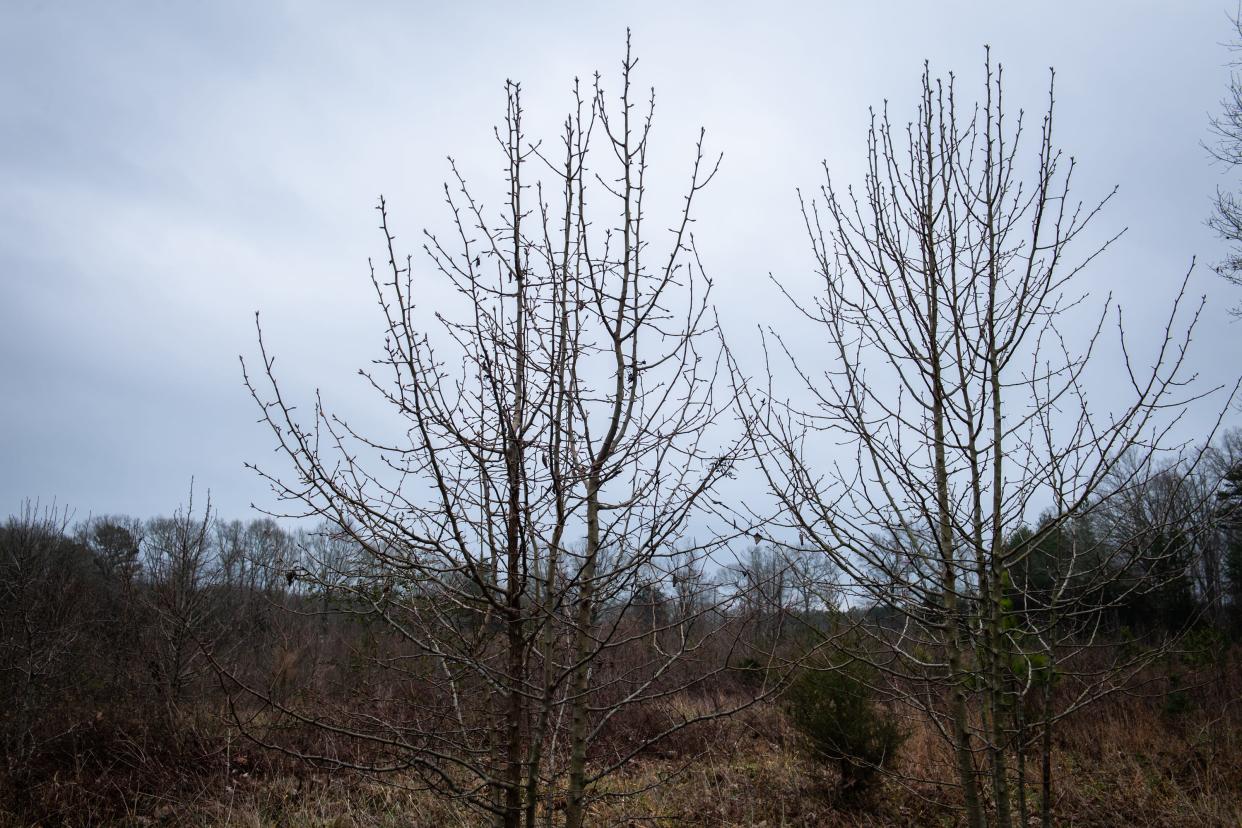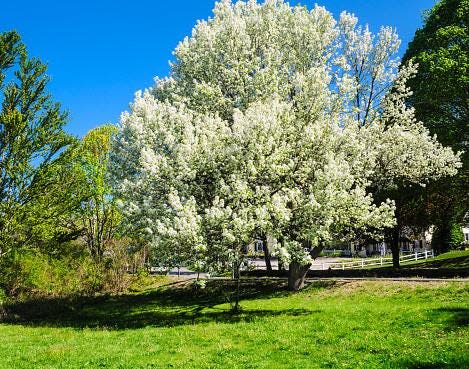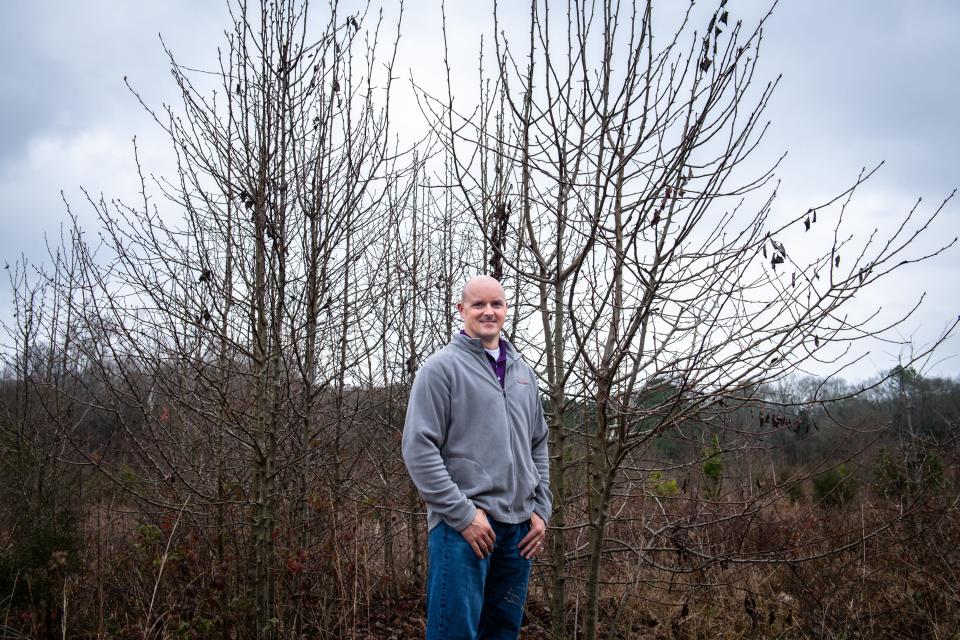It's being banned, killed with fire and there's a bounty. How to stop the Bradford Pear

One way to help the ecosystem is to grow more trees.
Another way is to kill a certain white flowering tree, said landscape designer and contractor Durant Ashmore, who has written about the tree for The Greenville News.
They are about to shed leaves and go into hiding among the other trees, but come March, they will be easy to spot. That's when the tree flowers and fills the air with a particular aroma.
There are bounties on this tree.
It will soon be banned in South Carolina and botanists are looking at fire, herbicides and other ways to kill the Bradford pear.

The Bradford pear veils an ecological nightmare with beauty and it's better for everyone if it's dead, Ashmore said.
The trees choke out other plants, especially in fallow fields which are empty pieces of land that are the forests of the future, Ashmore said.
The trees are set to be banned in South Carolina in 2024, giving plant nursery owners a transition period to sell leftovers while they can. The ban is on new sales of the plant starting Oct. 1, 2024.
More: 'Curse of the Bradford pear' is nothing to sneeze at
Even with the pending ban, it could be centuries until the Bradford pears are eradicated, Ashmore said.
“Our oaks, maples, hickories and so forth all are not being threatened for survival by Bradford pears, but they are being outcompeted.” Ashmore said.
All the native species in South Carolina will struggle as long as the Bradford pear is alive, he said.
So how do you kill a Bradford pear?
The Bradford pear will sometimes, if left alone, kill itself.
Not fast enough to get the tree under control, but its weak branches are one of the dangers of the tree.
Introduced into the landscape in the 1960s by the federal Department of Agriculture, Bradford pears were considered a sterile hybrid, but life finds a way.
In the 80s, researchers realized the trees broke excessively. The trees have a weak branch structure, called a "steep v crotch," that causes it to break from old age and high winds.
That weak branch intersection is why it's not a good idea to park a car underneath a Bradford pear.
The trees have a weak structure at the "v" of the branch, but strong in the other directions so it snaps and the part that snaps can be dangerous, Ashmore said.
The trees can create a "dead zone," with Bradford or Callery pears growing in thick masses with a dense canopy growing early in the year, keeping the light out for the rest of the plants, said David Coyle, an assistant Clemson University professor whose work includes forest health and invasive species.
Evolving into hybrids that puncture tires
To compensate for the weak branches, scientists developed similar pear trees that weren’t prone to breaking. These new trees soon interbred with the Bradford pears, creating a scene right out of Little Shop of Horrors, a plant hybrid gone wild.
That hybrid, no longer sterile, is a big part of why today's Bradford pears and related trees are invasive, wreaking havoc on nature and putting up a hard fight for removal, Ashmore said.
Although the trees have a relatively short lifespan of two decades, they could very well be on their way to a tenth generation of reproducing.
“The further along this process goes, the more these Callery pears resemble the ancient wild Chinese pears from the mountains which is just a thorny thicket mess.” Ashmore said. “It’s just an impenetrable thicket. The Callery pears have four-inch-long thorns, and they are as sharp as you can imagine.”
The thorns are strong and can puncture tractor tires. It makes it difficult to mow down or push down a field of growing Bradford pears.
The thorns are bad, they've injured people and livestock and can damage tires, Coyle said.

It's a serious plant problem and that's why Clemson has been offering a bounty on the tree. Rip out or cut down up to five Bradford pears, with the property owner's permission, and get native trees for free.
What about killing it with fire?
Coyle was a key part of the bounty program, but free replacement trees and education programs haven't stopped the trees from sprouting all over.
Stopping the sale of future trees could help but there are wildly reproducing wild trees all over.
So Coyle is looking at fire.
“Fire can reduce the chance of tire punctures because it dulls the thorn tip and weakens the overall strength. This is important because prescribed fire is a commonly-used land management tactic, and it may be useful.” Coyle said.
Fire alone cannot eliminate the Callery pear.
Callery pears resprout vigorously after fire, so Coyle and others are studying techniques to use fire to curb the tree for good.
Several different herbicides work to kill Callery pear and the exact best combination, for small and large trees, is being studied, Coyle said.
Not only do these trees pose detrimental effects on forests, but they also pose a threat to the food chain.
Arthropods, insects that are like caterpillars, are critical food for the survival of many species.

Callery pears aren’t particularly scrumptious snacks for those caterpillar-like creatures, Coyle said.
"Since few, if any, caterpillars feed on Callery pear, every Callery pear represents a food desert for birds," he said.
Where there are non-native plants like this, there is a noticeable decline in the number of birds, Coyle said.
The few birds that do come around exacerbate the damage done by Bradford pears by spreading the seeds in fallow fields, preventing those would-be forests from blossoming.
There are many native alternatives for gardeners to plant instead of Bradford pears, Coyle said.
An ornamental spring flower look can be dogwood, redbud or swamp titi. For bright fall foliage, try black gum, he said.
Ashmore recommends serviceberry, witch-hazel, and Carolina silverbell.
However, there are alternative trees that gardeners should avoid, like Chinese pistache and amur maple. There are also shrubs to avoid such as burning bush, privet and nandina, which are some of the worst non-native shrubs, the experts said.
There are many ecological problems, Ashmore said, but an easy fix is that darned Bradford pear tree, right outside your house.
Other tree species will struggle to survive as long as Bradford pears are growing in South Carolina.
"All species," he said. "All our native species.”
Please subscribe to the Independent Mail at independentmail.com/subscribe
This article originally appeared on Anderson Independent Mail: How to stop Bradford pear trees? Banning, killing with fire, bounty

